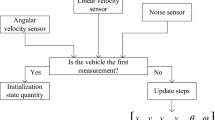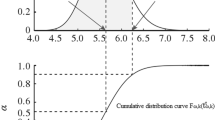Abstract
In order to realize the ubiquitous perception of urban traffic system integration, a universal technology architecture supporting multiple heterogeneous access, universalization and tailoring is needed to realize the interconnection and interoperability of perception systems in different application scenarios. Based on the analysis of typical application scenarios in traffic field and the performance characteristics of wireless and wired sensor networks, a method of bandwidth allocation for network resources in urban traffic application environment is proposed in this paper, especially in the scenario of high-speed train movement, in order to improve the transmission efficiency of wireless sensor networks. An information matching method for sensor networks is proposed. The correlation among multi-sensors is used to fuse the monitoring information in the coverage area of the sensing system, which is helpful to improve the resolution and accuracy of the system. The theory is applied to vehicle type recognition in traffic flow detection. The simulation results show that the proposed data fusion scheme has obvious advantages over the similar LEACH protocol in terms of energy consumption and fusion accuracy of common nodes.





Similar content being viewed by others
References
Achary UR, Hagiwara Y, Deshpande SN, Suren S, Koh JEW, Shu Lih O, Arunkumar N, Ciaccio EJ, Lim CM (2019) Characterization of focal EEG signals: a review. Futur Gener Comput Syst 91:290–299
Arikumar KS, Natarajan V, Clarence LS et al (2017) Efficient fuzzy logic based data fusion in wireless sensor networks[C]. In: Online international conference on green engineering and technologies. IEEE, pp 1–6
Baccarelli E, Chiti F, Cordeschi N et al (2014) Green multimedia wireless sensor networks: distributed intelligent data fusion, in-network processing, and optimized resource management[J]. IEEE Wirel Commun 21(4):20–26
Chen X, Li Y (2015) Optimal energy allocation to maximize network utility of wireless sensor networks based on data fusion[C]. In: International conference on intelligent systems design & engineering applications. IEEE Computer Society, pp 551–554
Chen S, Gao H, Liu Y et al (2016) In network data fusion for agricultural information on wireless sensor nodes based on JN5139[J]. Journal of Agricultural Mechanization Research 91(16):7648–7652
Dai Z, Yuanxiang LI (2015) Research on wireless sensor decision network of multi-layer agent data fusion and its multiplicity[J]. Comput Eng 41(3):198–203,217
Fei X, Xiaofang LI (2016) Wireless sensor network data fusion algorithm based on compressed sensing theory[J]. Journal of Jilin University 54(3):575–579
Haoyu L, Jianxing L, Arunkumar N, Hussein AF, Jaber MM (2018) An IoMT cloud-based real time sleep apnea detection scheme by using the SpO2 estimation supported by heart rate variability. Futur Gener Comput Syst. https://doi.org/10.1016/j.future.2018.12.001
Huang HP, Chen JT, Wang RC et al (2014) Compressed sensing algorithm based on data fusion tree in wireless sensor networks[J]. J Electron Inf Technol 36(10):2364–2369
Hui C, Pan J, Yan D et al (2014) Malicious nodes detection algorithm based on secure data fusion in wireless sensor networks[J]. Chinese Journal of Sensors & Actuators 27(5):664–669
Izadi D, Abawajy JH, Ghanavati S et al (2015) A data fusion method in wireless sensor networks[J]. Sensors 15(2):2964–2979
Ji S, Tan C, Yang P et al (2016) Compressive sampling and data fusion-based structural damage monitoring in wireless sensor network[J]. J Supercomput 74(7):1–24
Khamparia A, Singh A, Anand D et al (2018) A novel deep learning-based multi-model ensemble method for the prediction of neuromuscular disorders. Neural Comput & Applic. https://doi.org/10.1007/s00521-018-3896-0
Liu L, Luo G, Qin K et al (2017) An algorithm based on logistic regression with data fusion in wireless sensor networks[J]. Eurasip Journal on Wireless Communications & Networking 2017(1):10
Lu H (2013) Data fusion algorithm based on ultrasonic sensor network[C]. In: International conference on information computing and applications. Springer, Berlin, pp 1–10
Luo X, Chang X (2015) A novel data fusion scheme using grey model and extreme learning machine in wireless sensor networks[J]. Int J Control Autom Syst 13(3):539–546
Reliability BO (2014) Data fusion based on node trust evaluation in wireless sensor networks[J]. Journal of Sensors 2014(1):1–7
Santamaria-Granados L, Munoz-Organero M, Ramirez-Gonzalez G, Abdulhay E, Arunkumar N (2018) Using deep convolutional neural network for emotion detection on a physiological signals dataset (AMIGOS). IEEE Access. https://doi.org/10.1109/ACCESS.2018.2883213
Tan ND, Viet ND (2015) DFTBC: data fusion and tree-based clustering routing protocol for energy-efficient in wireless sensor networks[J]. Advances in Intelligent Systems & Computing 326:61–77
Tan C, Ji S, Gui Z et al (2017) An effective data fusion-based routing algorithm with time synchronization support for vehicular wireless sensor networks[J]. J Supercomput (4):1–16
Venkatesh V, Raj P, Balakrishnan P (2017) An energy-efficient fuzzy based data fusion and tree based clustering algorithm for wireless sensor networks[C]. In: The international symposium on intelligent systems technologies and applications. Springer, Cham, pp 14–27
Xiao L, Jian Y (2016) Wireless sensor network data fusion model based on compressed sensing theory[J]. J Comput Theor Nanosci 13(12):9515–9520
Yang Z, Chen MR, Wu W (2014) Algorithm for wireless sensor network data fusion based on radial basis function neural networks[J]. Appl Mech Mater 577(577):873–878
Zou T, Wang Y, Wang M et al (2017) A real-time smooth weighted data fusion algorithm for greenhouse sensing based on wireless sensor networks [J]. Sensors 17(11):2555
Acknowledgements
This work is supported by National Natural Science Foundation of China (No.71702015); China Postdoctoral Science Foundation (No.2017 M611810); Social Science Planning Major Application Project in Chongqing (No.2017ZDYY51); Chongqing Engineering Technology Research Center for Development Information Management Open Foundation (No. gczxkf201706); The Research platform Open Project in CTBU (No.1456041, No. KFJJ2017058, No. KFJJ2017061).
Author information
Authors and Affiliations
Corresponding author
Additional information
Publisher’s note
Springer Nature remains neutral with regard to jurisdictional claims in published maps and institutional affiliations.
Rights and permissions
About this article
Cite this article
Kong, F., Zhou, Y. & Chen, G. Multimedia data fusion method based on wireless sensor network in intelligent transportation system. Multimed Tools Appl 79, 35195–35207 (2020). https://doi.org/10.1007/s11042-019-7614-4
Received:
Revised:
Accepted:
Published:
Issue Date:
DOI: https://doi.org/10.1007/s11042-019-7614-4




